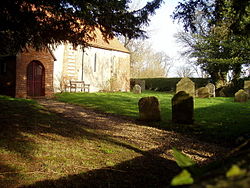Ashmansworth
| Ashmansworth | |
| Hampshire | |
|---|---|
 St James Church | |
| Location | |
| Grid reference: | SU415575 |
| Location: | 51°18’56"N, 1°24’18"W |
| Data | |
| Population: | 216 (2011) |
| Post town: | Newbury |
| Postcode: | RG20 |
| Dialling code: | 01635 |
| Local Government | |
| Council: | Basingstoke and Deane |
| Parliamentary constituency: |
North West Hampshire |
Ashmansworth is a village in northern Hampshire, found seven and a half miles south-west of Newbury in Berkshire, and nine miles north-east of Andover in Hampshire. The village is placed just south-west of the top of a ridge line running south which overlooks Highclere Castle and Newbury, with views over large areas of Berkshire and northern Hampshire.
The village is amongst the down that spread across the county border and is perhaps the highest village in Hampshire It lies within the North Wessex Downs Area of Outstanding Natural Beauty, and the area is popular with walkers, cyclists and horse riders.

The village is at the junction of five minor roads about 1 km west of the A343 between Newbury and Andover. Access has not always been as good as today.
A hamlet, Crux Easton, stands around a mile south-east of Ashmansworth.
Parish church
The village church, in the Church of England, is dedicated to Saint James the Great. It is now a Grade I listed building.[1]
The chuch is believed to have been built around the middle of the 12th century, to which date the nave belongs. The chancel dates from the end of the same century. Windows have been inserted at various dates and the east wall was rebuilt in 1745.[2] Wall paintings, mainly discovered in the 1800s and early 1900s, depict the life of Jesus, and probably date from the 1200s to the 1600s.[3]
History
Excavations in Church Farm indicate part of the hamlet was occupied in the Iron Age. The hamlet is also located in close proximity to the Oxdrove prehistoric route.
Some Roman pottery fragments have also been discovered in Ashmansworth.
Ashmansworth was granted as part of Whitchurch to the church of Winchester, some time in the 10th Century. The first reference to Ashmansworth is in a charter dated 909, in which Edward the Elder returned the hamlet to the community.[4] In 934, King Æthelstan (referring to the hamlet as ‘Aescmaeres’) directed that some of the land was to be put under the management of the bishop. It remained in possession of the bishopric until 1649.[5]
Obadiah Sedgwick (and, from 1654, his son, Obadiah) was the lord of the manor from 1649 to the late 1600s, when it returned to the bishop. The manor was sold in 1802 to the Earl of Carnarvon.
In 1811 a fire destroyed major parts of the village, along with parish records.
The population of Ashmansworth remained low during the 19th century. This was not helped by the restricted access to the land. A Black's Guide, published in 1871, described the village as being “among the least trodden districts and most secluded angles of the country, noteworthy only for its early English church”.
In 1901 a spokesman for the Archaeological Society described Ashmansworth as “a long scattered village, neglected and deserted in its aspect, with a rapidly decreasing population”. At this time the church had fallen into disrepair, probably as a result of it being subordinate to the East Woodhay parish.
Over the course of the 20th century the character of Ashmansworth changed rapidly, largely as a result of the intensive farming practices adopted after the Second World War.
The modern village has a central core, concentrated around the main thoroughfare where the Village Hall, built in 1952, village green, war memorial, former Plough Inn, former chapel and old school house are all located.
There are many key buildings in the village including eight listed buildings, some dating from the 18th century such as Plough Cottage and Pheasant Cottage.
Outside links
| ("Wikimedia Commons" has material about Ashmansworth) |
References
- ↑ Parish Council
- ↑ "St James - A Church near you". https://www.achurchnearyou.com/church/18333/find-us/.
- ↑ "St James Ashmansworth History". http://www.ashmansworth-pc.gov.uk/Ashmansworth-Parish-Council/UserFiles/Files/Welcome%20to%20St%20James.pdf.
- ↑ Robertson, A. J. (17 December 2009). Anglosaxon Charters, page 305. ISBN 9780521178327. https://books.google.com/books?id=zGGPx-41OtgC&dq=earl+hemele+grants+ashmansworth+to&pg=PA305. Retrieved 22 December 2019.
- ↑ A History of the County of Hampshire - Volume 4 pp 274-275: @ (Victoria County History)
